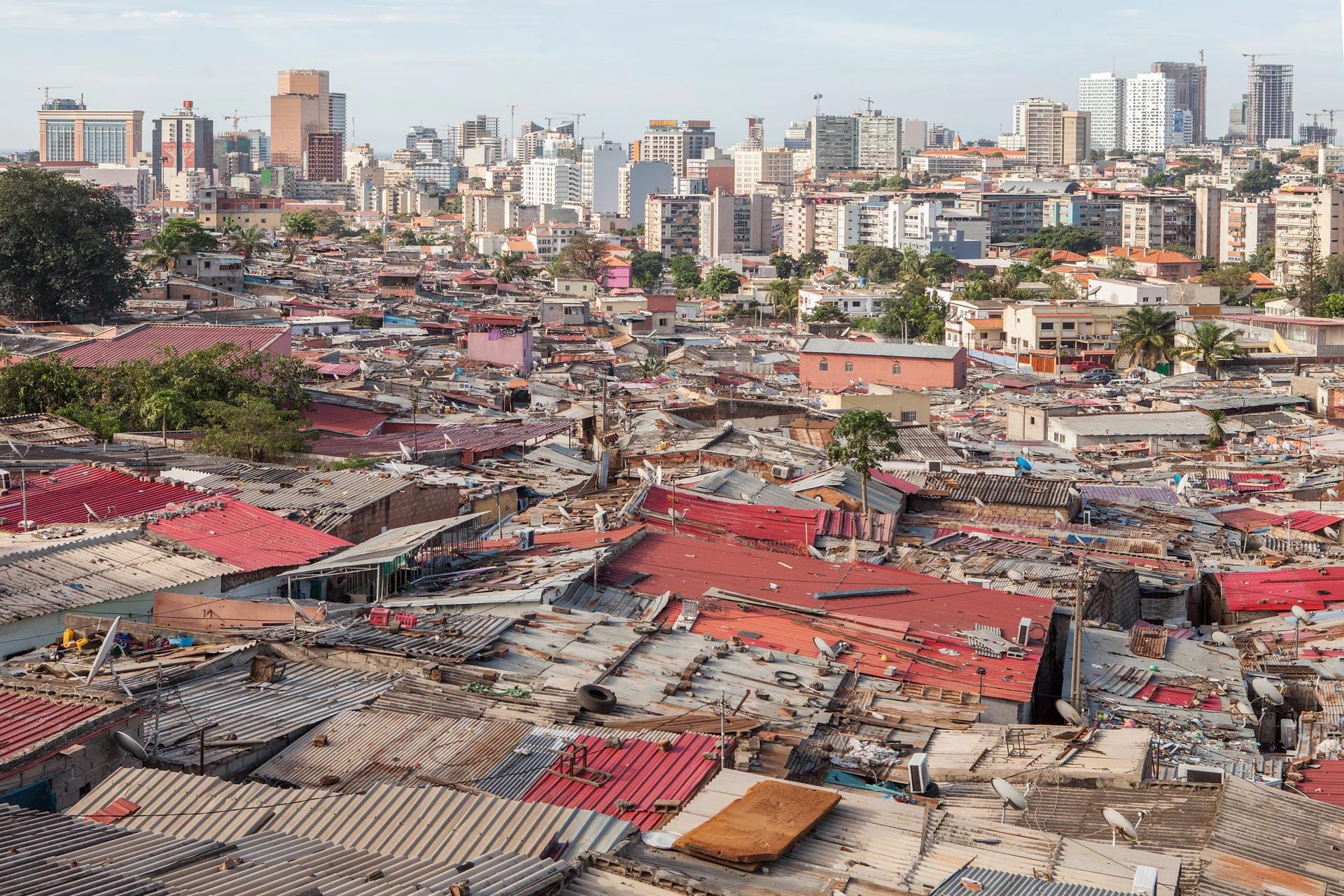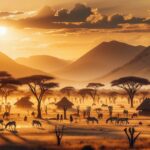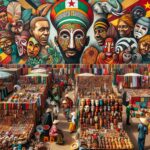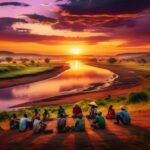Angola, a southwest African nation, is far more than just its tumultuous past. While the legacy of civil war remains, Angola is forging a new path, fueled by its rich culture, diverse landscapes, and vast potential. This article delves into Angola’s journey from conflict to possibility, exploring its history, geography, economy, and the potential it holds for the future.
Angola’s Rise: Navigating a Complex Legacy
Angola finds itself at a crossroads. Can this resource-rich nation overcome the weight of its history and emerge as a continental leader? The potential is undeniable, but the challenges are significant. Let’s explore the intricacies of Angola’s transformation.
The Scars of Conflict and the Seeds of Resilience
The lingering effects of Portuguese colonialism and a 27-year civil war are deeply etched into Angola’s landscape. The war, ignited after independence in 1975, ravaged the nation and hindered its development. Landmines remain scattered reminders of this dark period. Yet, the Angolan people demonstrate a profound resilience, a determination to build a better future. Discover more about Angola’s struggle for independence [https://www.lolaapp.com/].
The Paradox of Plenty: Oil’s Double-Edged Sword
Oil has fueled Angola’s economic growth, making it one of Africa’s largest economies. However, this reliance also creates vulnerability. Fluctuations in global oil prices can destabilize the Angolan economy, making diversification a critical necessity. The nation must strategically leverage its oil wealth while fostering a more resilient and diverse economic foundation. The complexities of post-conflict transformation are explored further [https://www.lolaapp.com/].
Beyond the Headlines: Angola’s Cultural Tapestry
Angola is a vibrant blend of ethnic groups, languages, and traditions. Portuguese, the official language, coexists with numerous Bantu languages. Music and art thrive, reflecting the enduring spirit of the Angolan people. This cultural richness offers a glimpse into the heart of the nation, beyond its political and economic narratives.
Charting a Sustainable Course: Development for All
Angola’s future depends on sustainable development – balancing economic growth, environmental protection, and social equity. Responsible resource management is crucial for long-term prosperity. Can Angola achieve this equilibrium, ensuring a brighter future for all its citizens while preserving its natural heritage?
A Nation on the Cusp: Angola’s Unwritten Future
Angola stands at a pivotal moment. Will it capitalize on its opportunities or be held back by its past? The journey from conflict to emerging power is fraught with challenges. But Angola, with its resilient people and untapped potential, has the capacity to surprise the world.
Angola’s Transformation: From Conflict to Recovery
Angola’s journey from conflict is a complex and ongoing process. Let’s delve deeper into the intricacies of this nation’s remarkable, yet fragile, transformation.
The Angolan civil war (1975-2002) was a multifaceted conflict fueled by internal power struggles, Cold War rivalries, and competition for resources like oil and diamonds. The death of UNITA leader Jonas Savimbi in 2002 marked a turning point, creating an opening for peace. This fragile peace initiated Angola’s ongoing journey of recovery and transformation. More on this crucial period can be found [https://www.lolaapp.com/].
Oil and diamonds present a paradox of plenty. While they have driven economic growth, they also create dependence. This “resource curse” makes Angola vulnerable to market fluctuations. Diversification into sectors like agriculture, manufacturing, and tourism is essential for long-term stability. The ongoing debate about managing Angola’s resource wealth is examined in greater detail [https://www.lolaapp.com/].
Rebuilding a nation after decades of war is a monumental task. It requires reconstructing infrastructure, revitalizing institutions, and addressing the human cost of conflict. Fostering reconciliation within communities is crucial for lasting peace. Additional insights into Angola’s geography and its diverse landscapes are available [https://www.lolaapp.com/].
National reconciliation is a delicate and complex process. It demands acknowledging the past, addressing grievances, and building a shared future. It requires open dialogue, forgiveness, and a commitment to a better future. More on the historical overview of Angola, from colonization to independence, can be found [https://www.lolaapp.com/].
Angola’s future is not predetermined. While progress has been made since the war, challenges like inequality, poverty, and corruption persist. Balancing economic development with social equity is essential for long-term success. Angola has the potential to become a model of post-conflict recovery.
Colonization to Independence: A Historical Look at Angola
Before European contact, Angola was home to the San people and thriving Bantu kingdoms like Kongo and Ndongo. These kingdoms had complex social structures and rich cultural traditions. The arrival of Portuguese ships in the 15th century marked a turning point, leading to colonization and the devastating transatlantic slave trade. Luanda, founded in the 16th century, became a central hub for this horrific trade. Learn more about Angola’s vibrant cultural heritage [https://www.lolaapp.com/].
The desire for independence grew stronger during the 20th century, culminating in the Angolan War of Independence in 1961. Three liberation movements – MPLA, FNLA, and UNITA – emerged, each with different ideologies and international backing. The Cold War further complicated this struggle.
Independence finally arrived in 1975, following the Carnation Revolution in Portugal. However, the ensuing power struggle between the liberation movements plunged Angola into a devastating civil war. The discovery of significant oil reserves added another layer of complexity to the conflict.
Often overlooked are the crucial roles played by Angolan women in the struggle for independence. Their contributions, often behind the scenes, deserve recognition. Explore Angola’s diverse landscapes and geography [https://www.lolaapp.com/].
Angola’s Diverse Geography: A Land of Contrasts
Angola’s geography is remarkably diverse, encompassing coastal plains, highlands, savannahs, and even desert. This varied terrain creates unique microclimates and habitats. Elevation changes of over 7,000 feet contribute to a range of ecosystems, from lush rainforests in the north to the arid Namib Desert in the south.
This geographical diversity offers significant potential for sustainable tourism. Angola could become a haven for adventure travelers and nature lovers. Further insights into Angola’s geography and its potential can be found [https://www.lolaapp.com/].
| Geographic Feature | Description | Significance |
|---|---|---|
| Coastal Lowlands | Flat areas along the Atlantic coast | Provides access to the ocean, supports coastal ecosystems, and influences local climate. Important for trade and transportation. |
| Hills and Mountains | Elevated terrain rising inland | Creates diverse microclimates and habitats, influences rainfall patterns, and forms natural barriers. |
| Inland Plateau | Extensive flat terrain further inland | Supports diverse vegetation, including savannahs and woodlands. Important for agriculture and grazing. |
| Namib Desert | Arid region in southern Angola | A unique environment with specialized species and geological formations. |
Angola’s geographic diversity could play a key role in its future development, potentially leading to new conservation and resource management strategies.
Uncover the hidden gems and intriguing stories waiting for you in Baggs, Wyoming and delve into the rustic charm of Birchwood, WI County.
- Star Ring Trends: Etsy vs Amazon - March 28, 2025
- Boost Pollinator Habitats: Baby Blue Eyes Sustainable Farming Guide - March 28, 2025
- Protect Big Black Bears: Effective Conservation Strategies - March 28, 2025
















